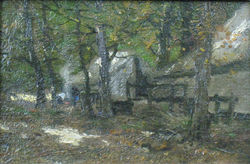CHARLES PAUL GRUPPE (1860-1940)
 "The Camp at Conesus Lake"7 1/4" x 10 1/2", Oil on Board 20114 |
|---|
Charles Paul Gruppe (1860-1940)
Landscape and marine painter Charles Paul Gruppe was born in Picton, Canada, September 3, 1860. Largely self-taught, Gruppe did study in Holland and a good portion of his work consists of Holland inspired scenes. He should not be confused with his son, artist Emile Gruppe, who painted many well-known New England scenes.
When Gruppe was ten, he moved with his family to Rochester, New York, after the death of his father. Interested in painting from an early age, he spent much of his time sketching and creating watercolors and oils. To help support his mother and sisters, he worked in a sign-painting shop, soon mastering the craft.
Eventually, at age twenty-one, he had earned enough money to travel steerage to Europe, where he traveled through France, Germany, and Holland, searching for a place to settle and practice his art. He was taken with Holland, perhaps attracted to its fishing villages with their picturesque boats and quaint houses, and decided to stay. He built a home and studio in the little fishing village of Katwyk Ann Zee and painted much of his European work in the vicinity of that town.
While in Holland, his skill at subtle coloration and careful draftsmanship became so identified with the Dutch School of painting that he was elected to the exclusive Pulchre Studio in the in the Hague, something highly unique for an American. Members of the Dutch Royal Family collected his work, which included portraits of the Dutch people as well as genre, marine, and countryside scenes. Many of his paintings are of the Zuider Zee and of Sheveningen, where he had a vacation villa. Charles Gruppe's work, This Painting, (ca 1903), which depicts a sailboat tied to a quay in icy waters, is one example of the silver gray tonalist paintings in which he specialized when he was in Holland.
Altogether, Gruppe spent over twenty years in Holland, becoming a celebrity artist and ultimately being patronized by the royalty of Europe.
His work is represented in many museums in America and Europe. Gruppe returned to America, becoming both a painter and dealer/broker in the art of Dutch painters, and popularizing Dutch art among American collectors and art connoisseurs. His son, Emile, who was to also become a well-known painter, was born at the family residence in Rochester in 1896. Soon thereafter the Gruppes moved back to Katwyk Ann/Zee, Holland, but in 1909, the family returned to the United States as the clouds of World War I gathered.
Although their ancestry was originally in the Hamburg area of Germany, they at this time added an accent to 'e' of the Gruppe name to make it appear less German.
The elder Gruppe, Charles, found an apartment/studio at Carnegie Hall in New York City. His son Emile also wanted to paint, and, in addition to teaching him himself, Charles sent him to the best teachers, including Frederic Bridgman for figures and drawing, Emil Carlson for landscapes and values; and Charles Hawthorne, for figures and color. Charles Gruppe had been an essentially self-taught artist but determined that his son would have the best teachers.
In 1925, after seeing an exhibition in New York that featured the beautiful winter harbor scenes of Gloucester by Frederick Mulhaupt, the Gruppe father and son team headed to Cape Ann, to see for themselves. "Mulhaupt got the smell of Gloucester on canvas", Emile had said. Father and son were already fond of seacoasts and seaports, and both Gruppes soon fell in love with Cape Ann.
They both continued to paint in the Cape Ann area for the rest of their lives. The elder Charles P. Gruppe died at age 80 in Rockport, Massachusetts, on September 30, 1940 at his studio where he had been established during the summers for 15 years. The remainder of each of those years, he had spent in New York City, where he was an active member of the Salmagundi Club.
Until 1929, the two Gruppes, father and son, shared a studio on Bearskin Neck in Rockport. Then Emile decided make his own fortune and moved to nearby Gloucester where he purchased an old school house on Rocky Neck.
Despite his stern look, Charles Gruppe was said to have a sunny and optimistic disposition. He had little formal education and no visible advantages in his early youth. All he did have was a strong love of painting which seemed inborn to him, as it was to generations of his family. He painted thousands of paintings in his life that are in the finest collections of Europe and America.
All four of his children were exposed to art and artists at tender ages, and eventually all established themselves in the arts: sculptor, Karl, was a member of the National Academy; musician, Paulo, is a cellist. Virginia was a watercolorist/art dealer who painted Rockport and Gloucester scenes and owned a gallery selling Gruppe and other paintings in Rochester, New York, where she lived until her death in the 1960s. Charles' son, Emile, was a highly regarded painter. Emile's son, Robert C. Gruppe is also an artist and operates a studio in Rocky Neck today; Paolo's son, Charles C. Gruppe, born 1928, became a painter in Connecticut. Work by this younger Charles Gruppe is often signed C. Gruppe, while work by the grandfather normally is signed Chas. P. Gruppe.
Charles Paul Gruppe was honored with numerous awards and medals, including gold medals at Paris and Rouen, and two silver medals (watercolor and oil) at the World's Fair in St. Louis in 1903.

